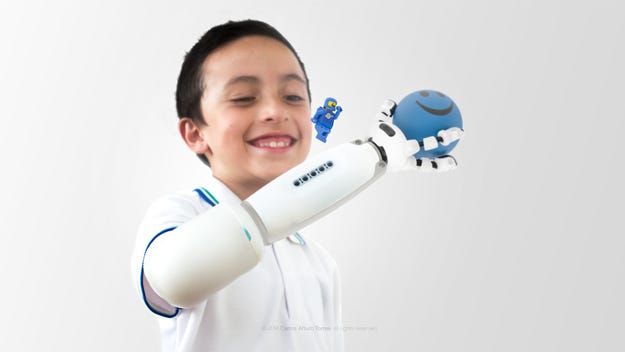How 3D printing is changing the world in five slides: IKO Prosthetic
There's a brilliant concept behind the IKO Creative Prosthetic System developed by Colombian designer Carlos Torres: Unleashing limbless children's creativity using Legos. The artificial limb allows pediatric amputees to swap robotic grippers for a laser-shooting spaceship, a backhoe or whatever the imagination and everybody's favorite ABS building blocks can conspire to create. The project recently was named one of the winners in the 2015 Core77 Design Awards competition.
July 23, 2015
There's a brilliant concept behind the IKO Creative Prosthetic System developed by Colombian designer Carlos Torres: Unleashing limbless children's creativity using Legos. The artificial limb allows pediatric amputees to swap robotic grippers for a laser-shooting spaceship, a backhoe or whatever the imagination and everybody's favorite ABS building blocks can conspire to create. The project recently was named one of the winners in the 2015 Core77 Design Awards competition.
With the help of the non-profit center for rehabilitation Cirec in Colombia, Torres, who is based in Chicago, conducted comprehensive research in orthopedics technology to advance his project. Armed with that knowledge, he flew to Denmark to the fabled Lego Future Lab.
"Turning the prosthesis into a toy was something that had to be explored," Torres wrote in his submission for the Core77 competition. "A kid does not always play, and one of the big insights during research pointed out that kids were also very interested in a functional tool. There had to be a right balance between a playful experience and something functional, and, moreover, something that could allow kids to explore their creativity, something they could be proud of." Using the Lego system was part of this solution, he adds, not just because of its creative content, but because of its social component. "This is a toy that gathers people around with a single goal: the pride of creation," but it also creates a social dynamic, explained Torres, that is every bit as valuable.
Lego is just the start. Imagine Marvel developing superhero modules, GE producing microscopes, or Nintendo creating compatible accessories, muses Torres.
With the exception of the arm socket, the entire model of the device was 3D printed using Rigid Opaque Vero materials from Stratasys (Eden Prairie, MN), Torres told PlasticsToday, noting that the final product, which may be available in early 2017, will be manufactured using conventional methods. Torres added that "3D printing is a great aid for prototyping and developing an idea."
To view the next slide, click on the arrow under the image.


About the Author(s)
You May Also Like




